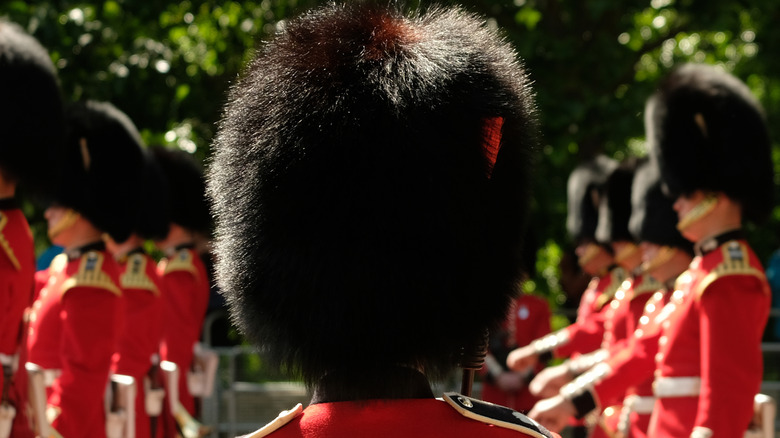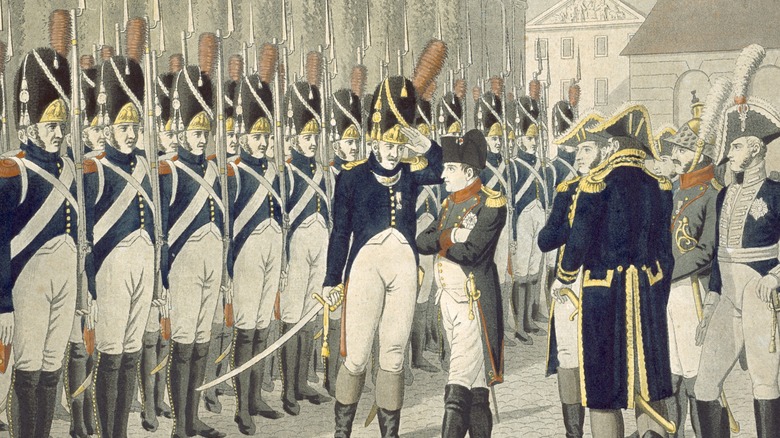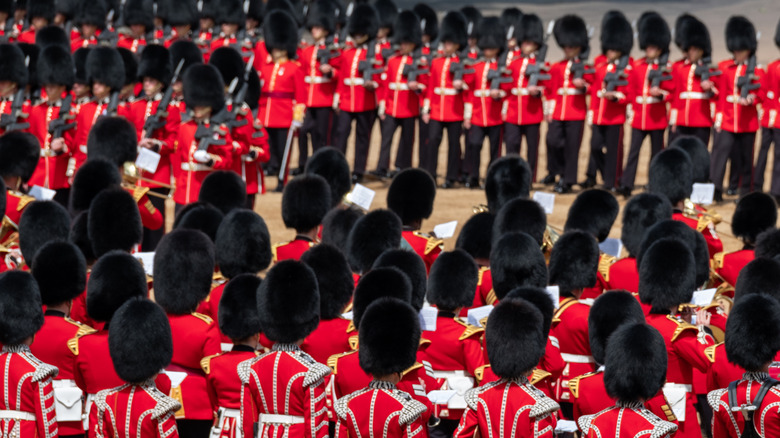The Real Reason British Guards Wear Bearskins
Have you ever looked at the tight-lipped, stony-faced royal guards of Buckingham Palace and wondered what is going on with their choice of headwear? Well, you're not alone. Millions of people across the world who were hooked on the Queen's elaborate funeral plans were once again fascinated by the famous royal guards' wardrobe choices.
According to the Ministry of Defence, the Royal Guards, or the ”Grenadier Guards” as they are occasionally called, are some of the oldest infantry regiments in the British Army. They were created by King Charles II in 1656, and they have since seen battle in various conflicts, including the Crimean War and both World Wars; their most recent conflict was Afghanistan. While there are quite a few hurdles to hop over first before you can even dream of donning the signature hat, the royal guards are still going strong and were an integral part of the late queen Elizabeth II's recent funeral ceremonies.
Despite being iconic across the world, the truth of these bearskin caps continues to encourage controversy, despite royal guards wearing them for centuries. The truth is, the fascinating origins of this intriguing choice in hat wear hearken back to the heyday of the British Empire (via National Interest).
The Sincerest Form of Flattery
Like their bright red tunics — an anonymous guard told Insider they were chosen years back for their ability to cover blood stains — there is a history behind their unique headwear as well. The black bearskin cap formerly had a historical purpose in signifying prestige and was worn by distinguished foot soldiers and guards. Surprisingly, the roots of these British black bearskin caps may be traced back to the Battle of Waterloo in 1815, per National Interest. This battle is often remembered as the bloody, climatic battle of the Napoleonic wars, in which Britain emerged victorious, and Napoleon Bonaparte was eventually exiled. Even if they weren't a fan of his politics, the British certainly admired Napoleon's flair for fashion.
According to British Heritage, Napoleon's imperial guard, comprised of his most elite soldiers, donned black bearskin helmets to appear more formidable to their foes. Understand that these bearskin caps were originally 18 inches tall, designed to make charging soldiers look terrifying in the fray of battle. Whether or not this intimidation game actually succeeded is anyone's guess.
What is known, however, is that the British afterward replicated this aesthetic for their own royal guards as a way of demonstrating their prestige and pride in their triumph, and the tradition stuck. However, the furry headgear was not the only thing the British borrowed; the royal gold bearskin hat chin straps are another borrowed element from the original bearskin caps. While they may appear amusing in the present day, some believe they serve a useful purpose in protecting the chin and determining exactly where an individual guard falls in the larger hierarchy of the royal guard. This is because individual regiments must wear this chain over the lip, while some wear it just above the chin (per Leading Britain's Conversation).
Are They Made From Real Bearskin?
So, where does Britain get the bearskin from? After all, black bears haven't called England home for quite some time. The solution is, predictably, controversial.
The black fur required for these bearskin caps is imported from Canada, according to British Heritage. These black bearskin helmets aren't cheap, with a wasteful ratio of using one culled bear to make one hat! Surprisingly, each one costs around £650 (around $746) to produce. In 2021, The Independent reported that the Ministry of Defence spends hundreds of thousands of pounds every few years when they order a fresh round of bearskin hats. The real kick in the teeth to some British citizens is that their tax money is indirectly being used to fund these new hats.
Furthermore, by importing Canadian bear fur, the Ministry of Defence is essentially supporting horrific fur farms and the killing of black bears. Many notable animal rights advocates have expressed outrage, and petitions to change the bearskin fur with a faux fur alternative have been increasingly frequent in recent years. According to National Interest, the British Army protests that the faux fear alternatives just aren't the same because the synthetic oils and materials used to make them become too waterlogged and lose their signature shape when it rains.
Given how famously bad British weather is and how deeply entrenched the British monarchy is in traditions, it could be a long time before these black bearskin hats finally become vegan.


